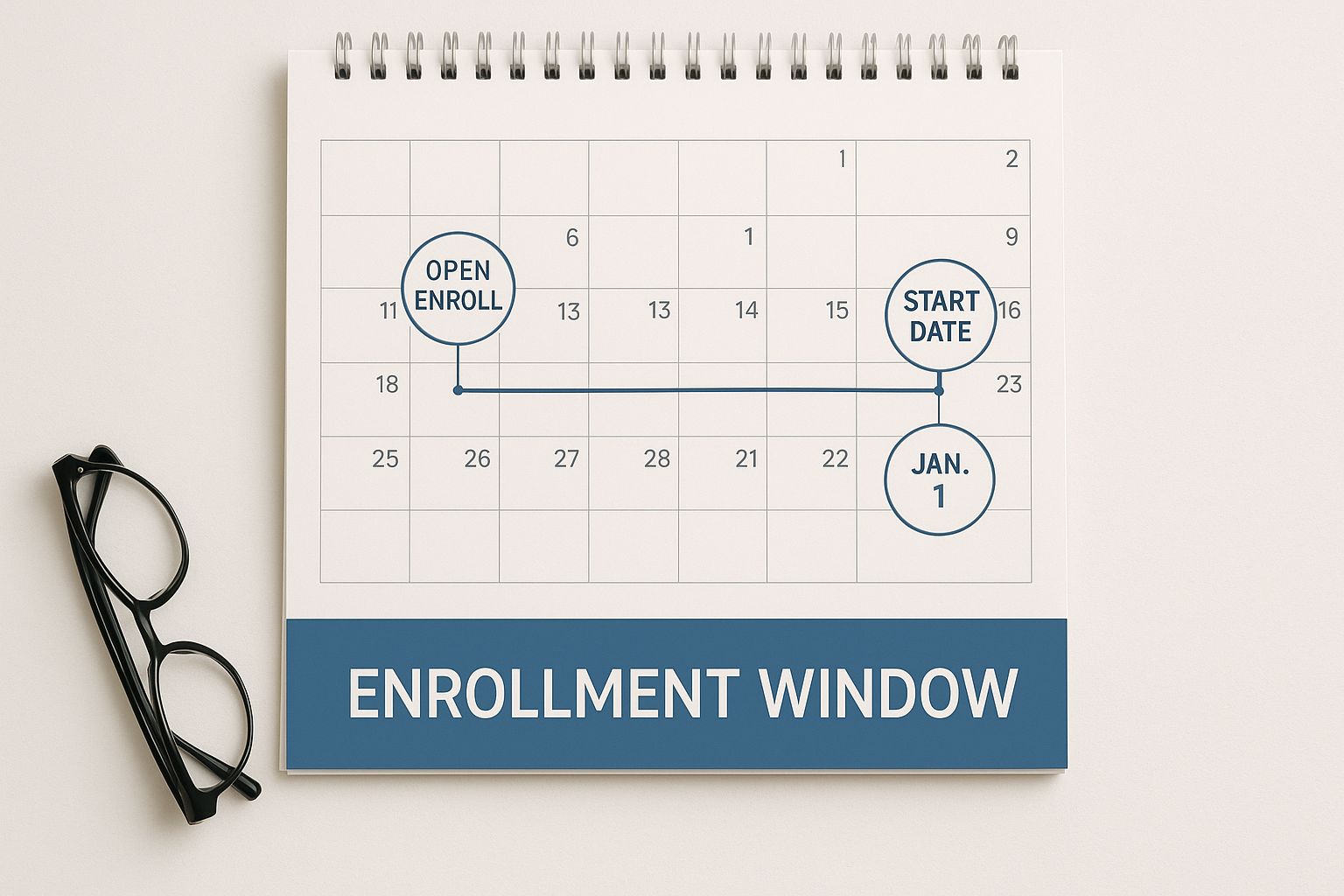Simply put, open enrollment is your annual benefits shopping window. It's that one specific, limited time each year when you get to make crucial decisions about your health insurance, dental, vision, and even your retirement accounts.
Think of it like renewing your most important subscriptions. Once that window slams shut, your choices are pretty much locked in for the entire year.
Understanding Your Open Enrollment Window

This structured annual period is nearly universal in the U.S. It’s not just a casual suggestion; a 2020 survey found that over 95% of organizations have a formal open enrollment period. It’s a standard, expected part of the employee benefits world.
This strict timeframe isn’t designed to be difficult. It’s actually what keeps the system stable and affordable for everyone. By having everyone enroll at the same time, insurance carriers can predict their costs and keep premiums from skyrocketing. Otherwise, people might only sign up when they get sick, which would drive up costs for all of us.
Open enrollment is your one guaranteed opportunity each year to align your benefits with your life's changes. Whether your family has grown, your health needs have shifted, or you're planning for the future, this is the time to act.
To help you get a clearer picture, we've broken down what open enrollment really means for you in a simple table.
Open Enrollment At a Glance
| Aspect | What It Means for You |
|---|---|
| The "When" | A specific, limited window once a year to make changes to your benefits. |
| The "What" | Your chance to enroll, switch plans, or add/remove dependents. |
| The "Why" | It keeps the insurance system stable and helps manage costs for everyone. |
| The "Who" | Anyone eligible for benefits, whether through an employer or the ACA Marketplace. |
| The Bottom Line | Miss it, and you’re generally stuck with your current plan until next year. |
This annual check-up is your moment to ensure your benefits package is still working for you and not against you, preventing nasty surprises down the road.
What You Can Typically Do
During this window, you hold the power. It's your time to:
- Enroll for the first time if you previously decided to waive coverage.
- Switch between different plans, like moving from a PPO to an HMO to better fit your budget or health needs.
- Add or remove dependents from your coverage, like a new spouse or a child who has aged out of your plan.
- Sign up for voluntary benefits, including extras like life insurance, disability coverage, or a Flexible Spending Account (FSA).
Truly understanding what open enrollment is and why it matters is the first step toward making empowered choices. And let’s be honest, insurance policies can be dense. Getting comfortable with understanding legal documents is a huge help, since these plans are complex contracts.
The Real Reason Open Enrollment Exists
Ever wonder why you can't just sign up for health insurance whenever the mood strikes? It might feel like a random, inconvenient rule, but there’s a really important reason for it. It’s what keeps the entire insurance system from falling apart.
Think of it like this: you can't buy car insurance after you've already had an accident. The system just wouldn't work. Health insurance is built on the exact same idea, designed to avoid something called adverse selection.
If people could sign up anytime, many would wait until they got sick or needed a major surgery. The insurance pool would fill up with high-cost members, and to cover those massive bills, companies would have to jack up prices for everyone. Suddenly, coverage would become completely unaffordable for the healthy people whose premiums are needed to balance things out.
Balancing Risk and Keeping Costs Down
Open enrollment solves this problem by getting everyone to sign up around the same time. This creates a balanced mix of healthy folks and those needing more care. By spreading the financial risk across a large, diverse group, costs stay manageable for everybody.
This isn't just a good idea; it's a structured system backed by federal rules. In the U.S., the Affordable Care Act (ACA) plays a big part by requiring large employers to offer coverage. This guarantees employees have a specific time each year to choose or change their benefits, with very few exceptions allowed outside this window.
That strict deadline isn't there to make your life harder. It's the foundation that prevents the insurance market from collapsing under the weight of unpredictable, expensive claims. It protects you just as much as it protects the insurer.
What About Major Life Changes?
Of course, life doesn’t always follow a schedule. What happens if you get married, have a baby, or lose your job in the middle of the year? Don't worry, the system has a solution for that: Qualifying Life Events (QLEs).
These specific events trigger a Special Enrollment Period (SEP). This gives you a new, temporary window to update your coverage to match your new reality. A QLE is the exception that proves the rule, showing that while life happens, the open enrollment period is still the standard for a reason.
Navigating Critical Deadlines and Timelines
Missing your open enrollment deadline is a costly mistake. Think of it like a train leaving the station—once it's gone, you're left on the platform until the next scheduled departure a year later.
Most companies and the Affordable Care Act (ACA) Marketplace set their open enrollment windows in the fall for a good reason. This timing allows all the paperwork and changes to be processed so your new coverage is ready to kick in on January 1st, ensuring a seamless transition into the new year.
This timeline isn't as intimidating as it sounds. This infographic breaks down a typical enrollment calendar, making the whole process feel much more manageable.

As you can see, the enrollment period is a fixed window. It won't wait for you, which means your timely attention and action are non-negotiable.
The Autumn Enrollment Rush
This fall timeline isn't just a coincidence; it’s pretty standard across the industry. When it comes to employer-sponsored plans, a whopping 77% of organizations kick off their open enrollment in either October or November. This is the busy season when HR departments are working overtime to communicate plan changes and deadlines.
One of the biggest hurdles they face is simply getting employees to read the materials, which is why paying close attention is so vital. You can find more insights on typical open enrollment trends on ifebp.org.
For those using the ACA Marketplace, the timeline is very similar:
- November 1: Enrollment typically opens its doors.
- December 15: This is often the last day to sign up for coverage that starts on January 1.
- January 15: The final, final deadline for enrollment in many states.
The single most important thing you can do is mark these dates on your calendar the second you get them. Whether it’s an email from HR or a notification from the Marketplace, treat this period like an unmissable appointment. It’s the key to protecting your health and your wallet for the year ahead.
Your Step-By-Step Preparation Checklist
Knowing the open enrollment rules is one thing, but actually getting ready for it is where the real work begins. Let's be honest, preparation is what separates a confident, smart decision from a last-minute guess that could cost you thousands.
This isn't just about ticking boxes; it's about turning you into an empowered consumer who knows exactly what they need.
First, you have to look back before you can look forward. Think about the last 12 months. How did you actually use your health plan? Tally up your doctor visits, prescriptions, and any other medical expenses. Did you ever even meet your deductible? Or were you paying a high premium for coverage you barely touched?
Answering these questions honestly is the single most important thing you can do. It’s a reality check that shows you where your money went and whether your plan was a good value or just a financial drain.
Once you have a clear picture of the past year, it’s time to think about what’s coming next.
Evaluate Your Upcoming Year
Life rarely stays the same, and your health plan needs to keep up. The perfect plan from last year might be a terrible fit for the year ahead. Ask yourself a few key questions:
- Are any major life changes on the horizon? This could be anything from getting married and planning for a baby to a child aging off your plan.
- Do you expect any new health needs? Think about planned surgeries, new medications, or managing a chronic condition for anyone in your family.
- Will your favorite doctors still be in your network? Provider networks change all the time. It’s crucial to verify your doctors and specialists are still covered to avoid surprise bills.
Get Your Finances in Order
Finally, it's time to talk budget. This goes way beyond just looking at the monthly premium. You need to account for the deductible, copays, and the out-of-pocket maximum to truly understand your total potential costs for the year.
If you need a hand weighing the financial trade-offs, our guide on how to choose health insurance for smart coverage is a fantastic place to start.
And for federal employees, part of this prep work includes understanding the Federal Employees Retirement System (FERS) and how it all fits together. A little prep work now ensures you make the best possible choice for both your health and your wallet.
Avoiding Costly Open Enrollment Mistakes

The biggest—and most expensive—mistake you can make during open enrollment is also the easiest one: doing nothing at all. Letting last year's plan just roll over feels simple, but it’s a massive gamble with both your health and your wallet.
Here’s the thing: insurance plans change every single year. Premiums go up. Your prescription coverage might shift. And, worst of all, the doctors and hospitals in your network can change. Imagine finding out your trusted family physician is suddenly out-of-network after you get a huge, unexpected bill. It happens all the time.
Many people fall into this trap, simply defaulting to their old plan without reading the fine print. This leads to underused benefits and serious financial headaches, a problem so common that it’s being studied by industry experts, as highlighted in a recent World at Work article about AI and open enrollment.
Underestimating Your Future Needs
Another easy pitfall is picking a plan based only on how healthy you were last year. Looking back is smart, but you also have to look forward. Are you thinking about starting a family? Do you have a feeling you might need a specific surgery this year?
Choosing a plan with a low monthly premium might seem like a win, but if it comes with a sky-high deductible, a single unexpected medical issue could drain your savings. It’s a classic case of being penny-wise and pound-foolish.
This is especially true for freelancers and entrepreneurs. If that's you, it's worth taking a moment to look into the best health insurance for the self-employed to find guidance that fits your unique situation.
Don't just plan for the health you have today; plan for the health you might need tomorrow. A thorough annual review is non-negotiable for your financial and physical well-being.
Overlooking Valuable Voluntary Benefits
Finally, don't get tunnel vision and focus only on the main medical plan. It's so easy to gloss over the "extras," but ignoring them is a big mistake. These voluntary benefits are often your financial safety net when life throws you a curveball.
Take a second look at these often-skipped options:
- Disability Insurance: This protects your paycheck if you get too sick or injured to work. It’s income protection, plain and simple.
- Critical Illness Insurance: If you're diagnosed with something serious like cancer or have a heart attack, this pays you a lump-sum cash benefit to help with expenses.
- Health Savings Accounts (HSAs): These are incredible tools with a triple tax advantage, letting you save for medical costs tax-free.
When you ignore these benefits, you’re leaving huge gaps in your financial protection. Open enrollment isn't just about picking a health plan; it's about building a complete shield against life's biggest "what-ifs."
What to Do If You Miss the Deadline
It’s that sinking feeling in the pit of your stomach—the open enrollment window just slammed shut, and you forgot to sign up.
Don’t panic. It happens. While the rules are pretty firm, you aren’t necessarily locked out of coverage for the entire year. There are some important exceptions built into the system for when life takes an unexpected turn.
This is where a Special Enrollment Period (SEP) comes in. Think of it as a second chance—a temporary window that opens up, allowing you to change your benefits outside of the normal timeframe. What triggers it? A major life change, officially known as a Qualifying Life Event (QLE).
A QLE is like a key that can unlock the benefits door right when you need it most. It’s a crucial safety net for when life doesn’t stick to the calendar.
Common Qualifying Life Events
Most QLEs give you a 60-day window from the date of the event to make changes to your coverage. It’s a short timeline, so you have to act fast. For example, if you’ve recently lost your job-based coverage, you'll want to quickly look into your options for health insurance without a job to avoid any gaps.
Below are some of the most common events that can trigger a Special Enrollment Period.
| Event | Typical Window to Make Changes |
|---|---|
| Getting Married or Divorced | 60 days from the event date |
| Having or Adopting a Baby | 60 days from the birth/adoption |
| Losing Other Health Coverage | 60 days from the loss of coverage |
| Moving to a New ZIP Code | 60 days from your move |
This isn't an exhaustive list, but it covers the big ones. The key is to know that these life changes give you a brief opportunity to get the coverage you need, even after the official deadline has passed.
Your Top Open Enrollment Questions, Answered
Alright, we’ve covered the what, why, and how of open enrollment. Now, let’s get into the questions we hear all the time. Think of this as your personal FAQ for navigating this tricky season.
Can My Employer Just Pick a Plan for Me?
Technically, yes. If you don't make a choice, many employers will just roll you over into the same plan you had last year. But letting this happen is a huge gamble.
Your life changes. Your family's needs change. And guess what? The insurance plans change, too—costs go up, networks shrink, and benefits get tweaked. Passively accepting a default plan is one of the easiest ways to overpay for coverage that no longer fits you.
Taking an active role in open enrollment is non-negotiable. It’s on you to review the options and lock in the best coverage for your life and your wallet for the year ahead.
What's the Real Difference Between an HSA and an FSA?
This one trips a lot of people up, but it’s simpler than it sounds.
Think of a Health Savings Account (HSA) like a 401(k) for your healthcare. It’s your money. You own the account, the funds roll over every single year, and you can take it with you if you switch jobs. It's a long-term savings tool.
A Flexible Spending Account (FSA), on the other hand, is more of a "use-it-or-lose-it" deal. The account is owned by your employer, and you generally have to spend the money within the plan year. It’s a great way to budget for predictable expenses, but it's not a permanent savings plan.
Missing important deadlines for benefits can have serious financial ripple effects, much like forgetting about other key dates. For instance, understanding the IRS penalties for late tax filing shows just how critical it is to stay on top of your financial to-do list.
Navigating your insurance options can feel like a puzzle, but you don’t have to solve it alone. At My Policy Quote, we offer clear, straightforward guidance to help you find the perfect fit.


